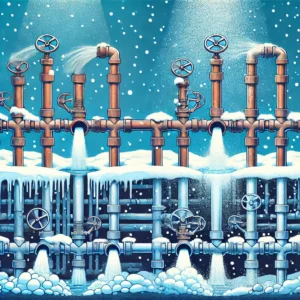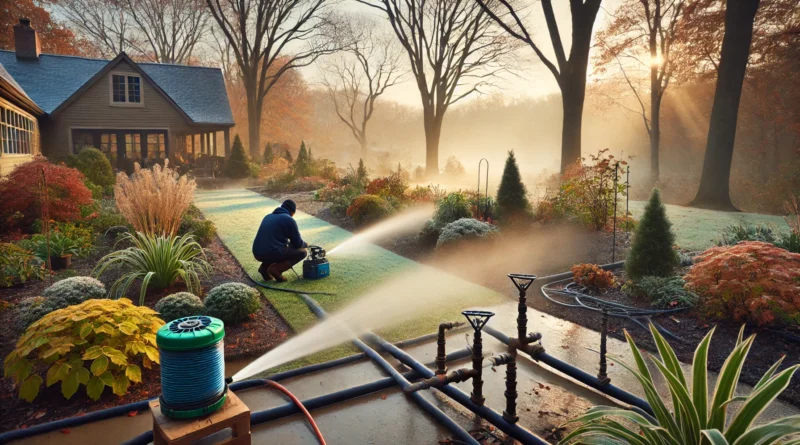Avoid Costly Repairs: Properly Winterizing Your Irrigation System This Season
As winter approaches, many homeowners overlook one crucial task that can save hundreds, if not thousands, of dollars in repairs: irrigation system winterization. When water is left in the pipes during freezing temperatures, it expands and can cause pipes to crack, sprinkler heads to burst, and valves to fail. Preparing your irrigation system for winter ensures it remains in peak condition, avoiding costly repairs in the spring. Whether you’re considering a DIY approach or hiring sprinkler winterization services, the right steps can help protect your investment and keep your landscape healthy year-round.
1. Why Irrigation System Winterization is Crucial
Winterizing your irrigation system is not just a precaution; it’s a necessary step to prevent significant damage when freezing temperatures set in. When water is left inside the irrigation pipes, valves, and sprinkler heads, it freezes and expands. This pressure can cause cracks in the system, broken sprinkler heads, and even leaks underground, all of which can lead to costly repairs.
Beyond the expense, improper irrigation system winterization can disrupt your landscaping plans come spring. A damaged system can lead to inconsistent watering, causing plants to either dry out or become waterlogged. Additionally, repairing the damage caused by freezing temperatures can be time-consuming and labor-intensive, especially if you have to dig up large parts of your yard to access broken pipes.
By properly winterizing your irrigation system, you ensure that your lawn and garden are ready for a fresh start in the spring. This small, preventive task can save homeowners a great deal of frustration, time, and money in the long run. Whether you choose to handle the process yourself or opt for professional sprinkler winterization services, preparing for winter is key to preserving the health of your landscape and the functionality of your irrigation system.

2. Signs You Need to Winterize Your Irrigation System
Knowing when to start the irrigation system winterization process is just as important as knowing how to do it. There are several key indicators that it’s time to prepare your system for the colder months, and paying attention to these signs will help you avoid last-minute scrambling or unexpected damage.
1. Dropping Temperatures
The most obvious signal is a drop in temperatures. As soon as nighttime temperatures begin to consistently fall below freezing (32°F or 0°C), your irrigation system is at risk. Even if daytime temperatures hover above freezing, the water in the system can freeze during colder nights, leading to cracked pipes and other damage.
2. Frosty Mornings
If you notice frost covering your lawn in the mornings, it’s a clear sign that freezing temperatures are imminent. Frost accumulation means that the ground temperature is dropping, which can have a direct impact on the water inside your irrigation pipes. This is a warning sign to initiate your winterization process immediately.
3. End of the Growing Season
As the growing season comes to an end, typically marked by the first signs of autumn foliage, it’s a good idea to start thinking about sprinkler winterization services or a DIY approach. Once your lawn and garden require less watering, it’s a prime time to begin the winterization process before freezing weather sets in.
4. Extended Freezing Forecasts
It’s always wise to keep an eye on the weather forecast. If an extended period of freezing temperatures is predicted, you should winterize your system promptly. A few nights of below-freezing temperatures might not cause immediate damage, but long-term exposure to these conditions can be devastating.
5. Regional Climate Considerations
The timing for winterizing your irrigation system also depends on your region. In colder climates, you may need to begin the process earlier in the season, while in more temperate areas, the winterization process can be delayed until the first freeze warning. Knowing your region’s climate patterns will help you gauge when to take action.
By watching out for these signs, you can ensure that you’re winterizing your irrigation system at the right time, preventing damage before it occurs. Early action is key to preserving your system through the winter months.
3. Step-by-Step Guide to Winterizing Your Irrigation System
Winterizing your irrigation system may seem like a daunting task, but by following a few clear steps, you can ensure your system is well-protected from the cold. Here’s a simple guide to help you winterize your system, either as a DIY project or to prepare before scheduling sprinkler winterization services.
1. Turn Off the Water Supply
The first step in the winterization process is to shut off the water supply to your irrigation system. Locate the main valve that controls water flow to your system and ensure it is fully turned off. This prevents water from entering the pipes during the winter, reducing the risk of freezing.
2. Drain the Pipes
Once the water supply is shut off, the next crucial step is to remove any remaining water in the pipes. There are three common methods to achieve this:
- Manual Drain: Open the manual drain valves at the lowest points in your system to allow gravity to flush out the water.
- Automatic Drain: If your system is equipped with automatic drain valves, the system will automatically release the water once the pressure drops.
- Blow-Out Method: This is the most effective method and involves using an air compressor to blow air through the system, forcing all the water out. If you are unfamiliar with this process, hiring a professional through sprinkler winterization services may be the safest option.
3. Open and Drain the Backflow Preventer
The backflow preventer is a key component of your irrigation system, preventing water from flowing back into the main water supply. It must be drained and opened during winterization. Disconnect it carefully, ensuring no water remains inside. This is particularly important as the backflow preventer is susceptible to freeze damage.
4. Insulate Valves and Above-Ground Components
Any above-ground parts of your irrigation system, such as valves or backflow devices, should be insulated to prevent freezing. Use foam pipe insulation or specialized covers to wrap these components securely. Even if the rest of the system is underground, above-ground components are more exposed to the elements and should be protected.
5. Shut Down the Controller
If your irrigation system is connected to a timer or controller, it’s essential to turn it off or switch it to a “rain mode” setting for the winter months. This prevents the system from turning on accidentally during freezing temperatures. Most controllers have an easy setting that allows you to pause watering schedules until spring.
Following these steps ensures your irrigation system is protected from the damage caused by freezing temperatures. If you prefer not to do this yourself, hiring a professional sprinkler winterization service is a convenient and safe option that can save you from potential costly repairs in the future.
4. The Role of Sprinkler Winterization Services
While many homeowners may choose to winterize their irrigation systems on their own, there are several benefits to considering professional sprinkler winterization services. Hiring experts to handle this process can save time, ensure thoroughness, and prevent costly mistakes.
1. Expert Knowledge
Sprinkler winterization services bring a level of expertise that most DIY enthusiasts may not have. Professionals are trained to understand the intricacies of different irrigation systems, ensuring that every step is completed correctly. From properly draining pipes to protecting valves and backflow preventers, they can identify potential problem areas that could be easily missed by someone inexperienced.
2. Access to Professional Equipment
One of the most critical parts of winterizing an irrigation system is the blow-out method, which requires an air compressor powerful enough to clear water from the pipes. Most homeowners may not have access to this specialized equipment. Sprinkler winterization services, however, come equipped with the necessary tools to ensure the job is done efficiently and effectively. Properly blowing out the system reduces the risk of pipes freezing and cracking during the winter.
3. Prevention of Costly Mistakes
A small error in the winterization process can lead to big problems down the road. For instance, failing to remove all water from the system or not properly insulating the backflow preventer can result in burst pipes and broken components when the temperatures drop. Professionals are well-versed in avoiding these pitfalls and can offer peace of mind that the system is fully prepared for the winter season.
4. Time-Saving Convenience
For those with busy schedules, hiring a professional to take care of the winterization process can be a significant time-saver. It eliminates the need to research the correct techniques, gather materials, or handle the process during an already busy fall season. With one phone call, you can schedule a service to prepare your system for winter, ensuring that you won’t have to worry about potential damage.
5. Cost vs. Repair Expenses
While hiring a sprinkler winterization service involves an upfront cost, it is far less expensive than the repairs needed if your irrigation system suffers from freeze damage. Cracked pipes, damaged valves, and broken sprinkler heads can quickly add up in repair costs. Investing in professional services minimizes these risks and ultimately saves money in the long term.
By choosing professional sprinkler winterization services, you’re not only protecting your irrigation system but also ensuring its longevity and optimal performance for seasons to come.
5. Maintaining Your Irrigation System Year-Round
While proper irrigation system winterization is essential to prevent damage during the colder months, maintaining your system year-round ensures that it performs at its best throughout all seasons. By taking a proactive approach to care and upkeep, you can extend the life of your irrigation system and ensure your landscape stays lush and healthy.
1. Spring Startup
After a long winter, it’s important to carefully restart your irrigation system in the spring. Begin by inspecting all system components for any damage that may have occurred during the winter months. Check for cracked pipes, damaged sprinkler heads, and malfunctioning valves. Next, gradually turn the water back on to avoid sudden pressure surges that could damage the system. Finally, reset your controller to reflect the new watering schedule for the growing season.
2. Regular Inspections
Throughout the year, it’s important to inspect your irrigation system regularly. Look for signs of wear and tear, such as leaking pipes, broken sprinkler heads, or inconsistent water flow. By catching these issues early, you can prevent more extensive damage and costly repairs. Seasonal inspections are particularly useful after heavy rainfall, storms, or landscaping work that may have affected the system.
3. Seasonal Adjustments
Adjusting your irrigation schedule based on the season is key to keeping your lawn and garden healthy. During the warmer months, you may need to increase watering frequency to account for higher evaporation rates. As the cooler weather approaches in the fall, gradually reduce watering frequency to prepare for winterization. A smart irrigation controller can automate these adjustments, saving water and ensuring your landscape gets just the right amount of hydration.
4. Sprinkler Head Maintenance
Sprinkler heads are one of the most vulnerable parts of your irrigation system. They can easily become clogged with dirt or debris, leading to uneven watering. Clean and inspect the sprinkler heads regularly to ensure they’re functioning correctly. If any are damaged or not spraying efficiently, replace them promptly to prevent water waste and ensure even coverage across your lawn.
5. Yearly Winterization
Of course, the cycle comes back to winterization. Each year, as temperatures drop, make sure to follow the winterization process to protect your system from freezing conditions. Whether you do it yourself or hire sprinkler winterization services, consistent attention to this step will prevent damage and extend the life of your system.
By maintaining your irrigation system year-round, you not only keep your landscape in top shape but also ensure your system remains efficient and functional for years to come.
Conclusion
Proper irrigation system winterization is an essential task that every homeowner should prioritize as the colder months approach. Failing to winterize your system can lead to costly repairs, damage to your landscape, and unnecessary stress. Whether you choose a DIY approach or hire professional sprinkler winterization services, ensuring that your system is ready for winter will protect your investment and keep your lawn and garden healthy year-round.
By taking proactive steps like shutting off the water supply, draining the pipes, and insulating vulnerable components, you can safeguard your irrigation system from freeze damage. Regular maintenance and seasonal adjustments throughout the year will further extend the life of your system and save you from unexpected repairs. This winter, make the smart choice to winterize your irrigation system and avoid the headaches and expenses of dealing with freeze damage.




